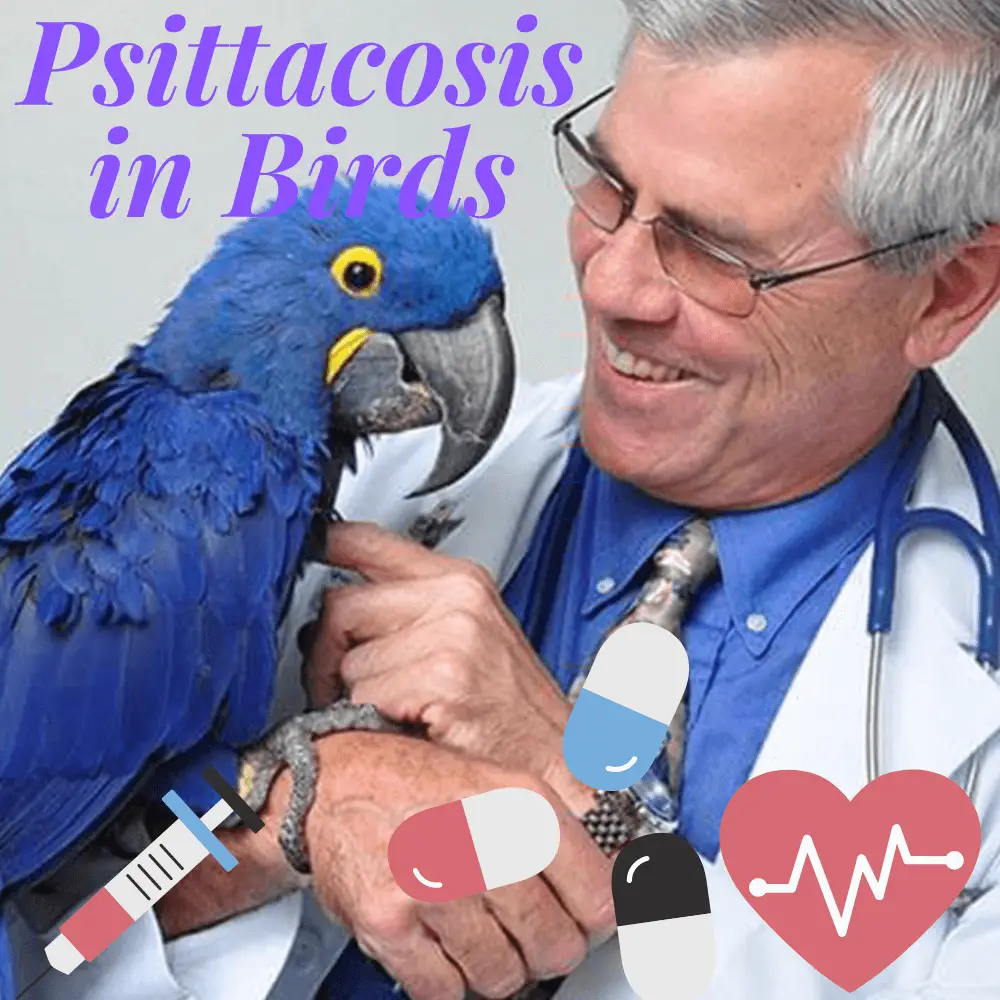
Psittacosis in Birds: Chlamydophilosis or chlamydia is seen in a different light Alain and his wife have lived for more than 15 years with Jano, their blue and yellow macaw parrot. Between acrobatics, Jano enjoys nibbling a potato chip with Alain or snuggling up to his neck to be cuddled during hockey games. Two weeks ago, Alain suffered a bad fracture to his leg which required complex surgery and several days of hospitalization. While recovering at home, he spends most of his time with Jano. They are inseparable!
Unfortunately, Alain was hospitalized again ten days after his return home, inconvenienced by respiratory discomfort. He died in hospital of complications from severe pneumonia a month after his admission. At the autopsy, the pathologist is clear. Cause of death: a complicated respiratory infection caused by Chlamydia psittaci.
The public health department is alerted and its investigation leads it to Jano. The parrot is presented to me for a medical evaluation. All the tests performed are normal except the serology result for chlamydia which is positive. Jano is therefore an asymptomatic carrier of the disease.
Alain and his wife had been in contact with the infectious particles of the bacteria for a long time, but their immune system had always managed to prevent an infection from settling in them. However, following his accident, Alain’s immune system had weakened and was unable to prevent infection. In addition, more frequent and closer contact had taken place between the two while resting at home. This situation put Alain much more in contact with the potential sources of the bacteria (aerosol particles from the stool and natural secretions from Jano’s nostrils, eyes, and beak).
It’s a shame that Alain would have very likely survived if his doctors had been informed of the presence of a parrot in his entourage and the possibility of contact with the bacteria Chlamydia psittaci, considering that Jano had never been tested. for this disease.
Jano was treated and now lives with Alain’s daughter.
Parrot Disease (Psittacosis): Symptoms, Treatment, and Prevention
Source: BioTales
Disease
Infection of humans with the bacterium Chlamydia psittaci causes a disease that is still poorly understood. The symptoms often mimic those of other illnesses such as the simple Influenza virus (common cold) or other bacteria that normally attack the respiratory system. Many bird enthusiasts are unaware of its existence although the carrier stage is commonly encountered in our companion birds. The problem in birds causes a lot of headaches because it is not always easy to diagnose, its treatment is expensive, and it is potentially transmissible to humans. Scouting for parrots remains a highly recommended practice and can help prevent dire situations.
When it comes to chlamydia in birds, many think of the STD of the same name first. However, there is no connection between the two infections, apart from their name.
To fully understand, you just need to know that there are four species of bacteria called Chlamydia and that each of them is responsible for a different health problem:
- Chlamydia trachomatis: Agent responsible for STDs in humans.
- Chlamydia pneumoniae: Agent responsible for respiratory infections in humans.
- Chlamydia pecorum: Causes health problems in ruminants (mainly abortion).
- Chlamydia psittaci: This is the bacteria responsible for Alain’s death. All parrots are sensitive to it to varying degrees. It can also infect a multitude of other bird species. Chlamydia is called zoonosis because an infected bird can transmit the disease to humans. This bacterium can also cause infections in several wild and domestic mammals, some amphibians as well as arthropods.
The term chlamydia is commonly used in popular vocabulary when it comes to Chlamydia psittaci infection in parrots and humans. However, this name is imprecise and actually describes a simple infection caused by one or other of the four bacteria called chlamydia. It is therefore a general and not a very specific term. On the other hand, when Chlamydia psittaci infects an animal (bird, mammal, or other) we should then speak of ornithosis. The word psittacosis should be reserved to refer to the same disease but in psittacines only.
In reality, there are no formal rules for the use of these terms and their use varies greatly from one author to another. Recently the name Chlamydia psittaci was changed to Chlamydiophila psittaci.
From now on, the word Chlamydiophilosis can be added to the list to designate this disease.
A real zoonosis
In the United States, 32 to 70 cases of human chlamydiophilosis are reported to health authorities each year. Among them, the disease is notifiable in several states. In Quebec, only one case was reported to RAIZO (MAPAQ’s zoosanitary alert and information network) in 2001. This is good, given all the possibilities of human contact with potential carriers or sick birds. It is possible to believe that many infections go unnoticed, go undiagnosed, or simply go unreported.
People with weakened immune systems (people under great stress or very tired, people with HIV or taking anti-rejection drugs after an organ transplant, the very old or very young children) are at greater risk of developing the disease. disease when exposed to the bacteria. People with healthy immune systems are much more likely to control an invasion of the bacteria. When diagnosed on time, human chlamydiophilosis is treatable and very rarely fatal (less than 1% of cases). However, left without proper care, the death rate can climb to 15-20%.
The life cycle of Chlamydophilla psittaci is complicated
Chlamidophilla psittaci normally lives inside the cells of its host. This intracellular life does it in the form of reticulated body responsible for the reproductive phase of the bacteria. The bacteria preferably choose the cells of the respiratory and digestive systems to reproduce. A large amount of offspring called elementary bodies is put back into circulation in the bird and excreted in the feces, nasal secretions, eyes, and mouth. This is the infectious stage of the disease. These elementary bodies cannot reproduce themselves, but are infectious and serve to infect other individuals. It is important to know that they are produced intermittently, mainly when the bird is under stress (its immune system weakens). The infection of another bird, animal, or human is done by inhaling these particles suspended in the dust. Once they enter the body, they lodge in the cells, transforming into reticulated bodies which will start another cycle. Elementary bodies survive for several months in the environment and are resistant to desiccation. For this reason, it is not always easy to find the disease. It all depends on the test used. If, for example, the test is based on looking for particles of the bacteria in the stool or nasal secretions, it may turn out negative while the parrot is infected. This false negative simply means that the bird is not in the phase of active excretion of elementary bodies at the time the sample was taken. You must therefore choose your screening test.
Disease in humans
Humans become infected by inhaling infectious bacteria or by mouth-to-mouth contact with an infected bird. Incubation of the disease is about 5 to 14 days, sometimes longer. While the infection goes unnoticed in some, others develop severe symptoms:
- Fever
- Chills
- Headache
- Myalgia
- Nonproductive cough
- Breathless
- Chest tightness
More rarely, the bacteria infects the heart (endocarditis, myocarditis), the liver (hepatitis), the joints (arthritis), the eyes (keratoconjunctivitis), the brain (encephalitis).
In pregnant women, the bacteria can cause fetal death.
Parrot disease
Incubation in the bird can vary from 3 days to several weeks. Some parrots do not develop the disease until several years after exposure to the bacteria. All this time, they will have been asymptomatic carriers, shedding particles intermittently.
The symptoms of this disease are very variable and nonspecific. They often mimic those with respiratory or digestive problems. Their severity depends on the virulence of the strain of the bacteria and the patient’s immune status. An affected bird will have one or more of these signs:
- Lethargy
- Anorexia with weight loss and secondary dehydration.
- Spiky plumage
- Runny nose and/or eye (rhinitis, conjunctivitis)
- Greenish diarrhea (enteritis)
- Yellow urates (biliverdinuria secondary to hepatitis)
- Neurological problems secondary to central nervous system damage
- A significant decrease in fertility and deaths of babies in the nest is to be expected.
- In cockatiel, chlamydophilosis sometimes causes semi-paralysis.
- In very young birds, an acute generalized infection sometimes occurs which results in rapid death without any signs being seen.
Prevention
The quarantine of newly arrived birds is essential. A screening test is strongly recommended. Simple details make it possible to avoid potentially contaminating situations as much as possible.
- Change the cage bottom paper frequently to prevent the stool from drying out easily and forming dust that may contain infectious particles. Moistening the paper before handling it is also recommended.
- Wet the floor with disinfectant before sweeping.
- Do not vacuum the bird room, as this easily suspends dust.
- Clean floors frequently with a disinfectant solution. A contact time of 5 minutes is recommended.
Contagious particles of Chlamydia psittaci are deactivated by heat and by different disinfectants:
- Quaternary ammonium diluted 1/1000 (quatsyl)
- Isopropyl alcohol 70%
- Lysol 1%
- Bleach diluted 1/100
The vapors of these products are irritating. Make sure to rinse well and not use them around parrots.




















